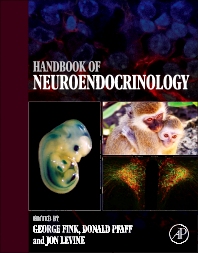Books in Neuroendocrinology
Books in Neuroendocrinology
- 1st Edition
- April 27, 2015
- Edgar Garcia-Rill
- English
- Hardback9 7 8 0 1 2 8 0 1 3 8 5 4
- eBook9 7 8 0 1 2 8 0 1 6 3 2 9

Waking and the Reticular Activating System in Health and Disease
- 1st Edition
- September 14, 2014
- Ronald Ross Watson
- English
- Paperback9 7 8 0 1 2 8 1 0 3 0 7 4
- eBook9 7 8 0 1 2 4 2 0 2 4 0 5

Modulation of Sleep by Obesity, Diabetes, Age, and Diet
- 1st Edition
- Volume 124
- August 28, 2014
- Eric Fliers + 2 more
- English
- Hardback9 7 8 0 4 4 4 5 9 6 0 2 4
- eBook9 7 8 0 4 4 4 6 2 6 1 2 7

Clinical Neuroendocrinology
- 1st Edition
- January 3, 2013
- Clete Kushida
- English
- Hardback9 7 8 0 1 2 3 7 8 6 1 0 4

Encyclopedia of Sleep
- 1st Edition
- January 3, 2013
- Clete Kushida
- English
- Hardback9 7 8 0 1 2 3 7 8 6 1 0 4

Encyclopedia of Sleep
- 1st Edition
- August 31, 2011
- George Fink + 2 more
- English
- Hardback9 7 8 0 1 2 3 7 5 0 9 7 6
- eBook9 7 8 0 1 2 3 7 8 5 5 4 1

Handbook of Neuroendocrinology
- 1st Edition
- July 23, 2009
- Anne M. Etgen + 1 more
- English
- Hardback9 7 8 0 1 2 3 7 4 9 3 9 0
- eBook9 7 8 0 0 8 0 9 5 8 5 8 3

Molecular Mechanisms of Hormone Actions on Behavior
- 1st Edition
- Volume 170
- July 25, 2008
- Rainer Landgraf + 1 more
- English
- Hardback9 7 8 0 4 4 4 5 3 2 0 1 5
- eBook9 7 8 0 0 8 0 9 3 2 4 7 7

Advances in Vasopressin and Oxytocin - From Genes to Behaviour to Disease
- 1st Edition
- Volume 7
- July 7, 2008
- Adriana Del Rey + 2 more
- English
- Hardback9 7 8 0 4 4 4 5 3 0 4 0 0
- eBook9 7 8 0 0 8 0 5 5 9 3 6 0

The Hypothalamus-Pituitary-Adrenal Axis
- 1st Edition
- Volume 167
- December 14, 2007
- E. Ronald de Kloet + 2 more
- English
- Hardback9 7 8 0 4 4 4 5 3 1 4 0 7
- eBook9 7 8 0 0 8 0 5 5 6 4 7 5
